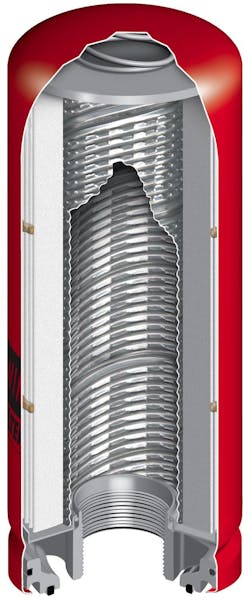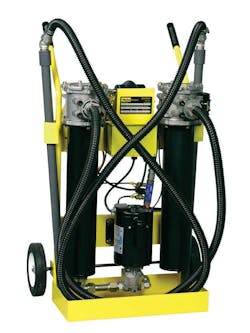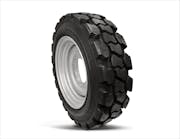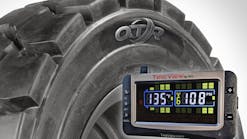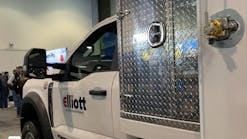Hydraulic Fluid Basics: Formulation, Selection, Maintenance
Hydraulic oil ranks high among fluids with multi-function capability. True, for sheer utility, it can’t match olive oil, which through the centuries has been used as food, lubricant, fuel, medicine, and in religious rites. But, hydraulic oil does serve as an energy-transmission medium, heat-transfer medium, sealant, and lubricant as it powers buckets, blades, and breakers, for example, or propels hydrostatically driven machines, or actuates multi-disc clutches and brakes.
To meet the requirements of these varied applications, hydraulic oil’s formulations are numerous.
“There is a wide variety of hydraulic fluids available on the market today, and not all created equally in terms of their performance or intended application,” says Felix Guerzoni, product application specialist for Shell Global Solutions.
“While most are the conventional, mineral-oil-based, zinc-containing type,” says Guerzoni, “there also are ashless [zinc-free] fluids—and both types are available in standard or high-viscosity-index grades. In addition, synthetic hydraulic fluids are available, along with those that are less flammable or fire-resistant—including water glycol, phosphate ester and synthetic ester—as well as biodegradable fluids, both natural and synthetic ester types.”
When referring to this broad range of formulations, the term hydraulic “fluid” is a more encompassing term than hydraulic “oil.” Also, for this discussion, “hydraulic fluid” refers to products marketed as such, although other types of fluids—engine oil, universal tractor transmission oil, and automatic transmission fluid, for instance—often are specified for hydraulic applications.
(Although these alternative fluids are widely used, a developing debate in the industry questions whether their use will provide the same performance as newer, purpose-formulated hydraulic fluids designed to cope with higher temperatures and pressures, higher pump capacities, and the challenges posed by diminished fluid capacities in smaller reservoirs that limit time for systems to dissipate air and water.)
To illustrate Guerzoni’s point about the diversity of hydraulic-fluid formulations, we randomly selected a major supplier and noted the range of formulations. Seven distinct product lines are available, differing in formulation (and price) from a basic fluid with additives only for corrosion and oxidation resistance, to “synthetics” with a long list of additives and with engineered molecules that keep viscosity relatively constant through a wide temperature range.
Basic hydraulic formulations
According to Guerzoni, all hydraulic fluid is composed of a base fluid and additives, with the base fluid typically constituting 98-plus percent of the formulation. The exact formulation, he says, requires balancing the characteristics of the base fluid and the additive package to achieve optimum performance in an intended application.
Fundamentals of the formulation, he says, involve the quality of the base fluid, as well as the selection of specific additives, which can include anti-oxidants, anti-wear and anti-foam agents, demulsifiers/emulsifiers (to control water), rust/corrosion inhibitors, and, when required, viscosity-index improvers.
“How well hydraulic fluids resist hydrolysis [rupturing of chemical bonds in the presence of water], the level of anti-wear performance over prolonged periods, resistance to forming deposits and sludge, and how readily filterable they are,” says Guerzoni, “are all characteristics controlled through careful selection of base fluids and additives.”
Without wading into technical details, base fluids are classified into API (American Petroleum Institute) “Groups,” ranging from Group I to Group V. Groups I, II, and III are derived from crude oil, with Group III considered a “synthetic” in North America, because it is highly refined and may have certain of its molecules chemically altered. Group IV fluids, called polyalphaolefins (PAOs) or “true synthetics,” have engineered molecules that are uniformly built up from molecules that can originate in crude oil. Group V essentially includes all other base fluids that don’t fit elsewhere.
“Fluids have changed as hydraulic systems have become more compact and operate at higher temperatures and pressures,” says Thelma Marougy, principal engineer for lubricants and fluids, Eaton Corp. “Most are now formulated with API Group II and Group III oils, which have better oxidation resistance and better thermal stability.”
According to Jeff Snyder, industrial brand specialist, Chevron, base fluids impart different properties to the finished fluid that may be beneficial to certain users.
“Modern hydraulic systems operating under higher temperatures and pressures need higher-quality fluids formulated with Group II or better base stocks,” says Snyder. “High-performance fluids aren’t for every situation; there is a price/value relationship to be considered. Chevron, as do other major fluid suppliers, offers hydraulic fluids that meet the price/value relationship for most operating situations.”
Recent hydraulic formulation refinement
According to Snyder, refinement of hydraulic fluid in the past several years includes the development of formulations with high-viscosity-index (HVI) and low-shear characteristics. He explains:
“The ‘viscosity’ of a fluid refers to how it flows; the ‘viscosity index’ refers to how it flows over the range of temperatures in which it operates. Viscosity usually is measured at two temperatures, 40C and 100C. If a particular fluid has a viscosity of, say, 40 at 40C and 6.5 at 100C, you can plot these points on a graph to illustrate how viscosity changes with temperature. If you add a viscosity-index improver, the line on the graph gets flatter. A high-viscosity-index fluid is aimed at maintaining consistent qualities across a wide temperature range.”
An equipment manufacturer’s selection of fluid viscosity, says Snyder, usually is based on the requirements of the system’s pumps. HVI fluids, he says, perform more like the manufacturer intends.
Snyder further explains that viscosity-index (VI) improvers are petroleum-based, engineered molecules, similar in shape to a coiled spring, that contract when cold and expand as the temperature rises—thus their ability to maintain more consistent viscosity. In addition, he says, VI improvers today can be made to be more resistant to shear, that is, more resist to breaking apart in use.
“There are a number of viscosity-index improvers available,” says Marougy, “and the longer the molecule within the same type chemistry, the less shear-stable it will be when exposed to mechanical shear. When molecules break down, the viscosity will go down.”
Marougy would like hydraulic-fluid suppliers to publish the shear-stability of their fluids in order to provide users with a basis of comparison. Snyder is of the same opinion, saying that two fluids could be marketed as low-shear, but one could “shear-down” in the first 15 or 20 hours of operation. If that occurs, he says, viscosity might fall out of the range required by the pump and accelerate wear.
According to Chevron’s Snyder and Shell’s Guerzoni, both companies have tested their newest premium hydraulic fluids against typical anti-wear formulations recommended by equipment manufacturers and found gains in fuel economy with the premium fluid. These fluids in today’s market, says Snyder, reduce metering and pump losses for improved efficiency. (The recently released ASTM D7721-11 standard, “Standard Practice for Determining the Effect of Fluid Selection on Hydraulic System or Component Efficiency,” addresses procedures for such testing.)
For decades, zinc dithio-phosphate (ZDDP) has been the staple additive in hydraulic fluid for combating wear and oxidation. In the past couple years, however, zinc-free formulations have become widely available, usually seen in a supplier’s premium fluids. But that said, ZDDP formulations are still widely available, and at least one major supplier markets a premium fluid with an extra-high ZDDP content.
If ZDDP is not used, a more expensive sulfur/phosphorus-based additive usually is substituted, says Marougy, and these formulations may be called “ashless,” because they leave behind no residue when they decompose over time. Reasons given for developing zinc-free formulations include their increased resistance to sludge and varnish formation at high temperatures, their resistance to hydrolysis, and their environmental friendliness (no heavy metals).
“There is no extensive experience about the anti-wear characteristics of zinc-free formulations,” says Marougy, “but fluid suppliers are saying that these formulations will provide comparable anti-wear protection for pumps and other components.”
Practical considerations when selecting hydraulic fluid
When selecting hydraulic fluid, all the experts agree that users should follow the equipment manufacturer’s recommendations, paying particular attention to the recommended viscosity grade. If equipment works frequently in environments that cause extremely high operating temperatures, however, Chevron’s Snyder suggests consulting with the machine manufacturer and a knowledgeable fluids supplier about adjusting the recommended viscosity of the fluid to best meet the machine’s viscosity requirements under the operating conditions.
But when selecting an appropriate fluid, how much can you learn from the label on the container?
“In some instances,” says Snyder, “labels can be ambiguous, because they refer to industry standard tests—and the fluid can definitely meet those tests upfront. But the tests don’t measure the performance of the fluid over the life of its application. That’s the difficult part of reading the label.”
Shell’s Guerzoni is of like mind, saying it’s important to know whether a particular product simply meets the manufacturer’s requirements, or has been formally “approved” by a manufacturer, an approval often requiring a fluid supplier to submit samples to the manufacturer for validation testing. If fire-resistant fluids are required, he says, look for approval from Factory Mutual, a testing and certification organization.
Once the fluid is on site, storing and top-off practices become important. Chances are that large fleets store hydraulic fluid in drums, and if so, the experts advise storing the drums on their sides—undercover, if possible—to avoid water and dirt ingress. If fluid is stored in bulk tanks, says Donaldson Filtration Solutions, best practices involve filtering the fluid both as it is placed in storage and as it is dispensed, typically to an ISO (International Standards Organization) standard of 16/14/11. Also, desiccant breathers on bulk tanks help control water contamination, as they do also on machine reservoirs.
Marougy suggests that fluid be checked for sediment and for clarity, saying that a hazy fluid could indicate excessive water (which can diminish lubricity effectiveness), excessive fines contamination, or the mixing of incompatible fluids. She suggests that added fluid be filtered using a filter equivalent to or finer than that on the machine.
Hydraulic fluid cleanliness usually is guaranteed at the point of manufacture, says Guerzoni, but if the product is sold via a distributor and repackaged at that point, then cleanliness can be compromised. By agreement with a supplier, fluids can arrive at the user’s operation meeting a desired cleanliness level, he says, but to capitalize on these arrangements, routine maintenance should involve meticulous practices, including dedicated drum pumps, sealed top-off containers, and, if used, dedicated filter carts.
For hydraulic system health, Marougy suggests that three “excesses” be avoided—excessive particulate contamination (from poor maintenance events, improper reservoir breathers, and worn cylinder seals); excessive water contamination (from improper fluid storage, lack of water-absorbent reservoir breather, leaking heat exchanger, or worn cylinder seals); and excessive heat (from improper operating practices or system design).
Marougy also explains that the recommended fluid for a mobile hydraulic system might use a water-control additive that either “emulsifies” or “demulsifies” water in the system. Emulsifiers keep water suspended in the fluid to lessen the possibility of pumps ingesting a devastating slug of water; demulsifiers separate water from the fluid, and machine manufacturers may recommend periodically draining water from the reservoir.
A fluid-maintenance technique that receives universal endorsement from the experts is consistent analysis by a qualified laboratory. Chevron’s Snyder suggests establishing an interval for analysis based on the severity of the machine’s application—in consultation with the equipment manufacturer and the fluid supplier. But keep an open mind about adjusting the schedule, he says, especially if the application changes significantly or if test results indicate a more aggressive sampling schedule.
“Also important when setting up an analysis program,” says Guerzoni, “is to select the right set of tests to provide the most information, not only about the fluid, but also the equipment. Fluid analysis programs should contain, as a minimum: fluid viscosity; total acid number; water content; elemental analysis by ICP [inductively coupled plasma technique] to determine wear and contamination; particle count; and additional testing, including varnish-forming potential (oxidation) by FTIR [Fourier Transform Infrared].”

